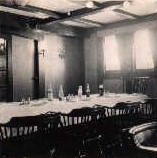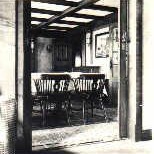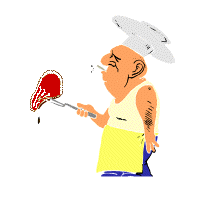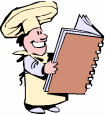
Food onboard. |

One week's "official" ration |
FOOD and DRINK The " ARTICLES " defined the quantity of food and water to which we were entitled. (See copy further down this page ) There had been no change in the allowance for the last 100 years, other than we were now entitled to 28 quarts ( 7 gallons ) of fresh water per week .That was 2 quarts more than when Valerie's ancestor Captain Palfry signed on his crew for the vessel " Jessie " in 1869. FRESH WATER The importance of availability was never underestimated. 1) The daily use was monitored by sounding the water tanks daily. 2) Taps were of a spring loaded type which had to be pressed down for the water to flow. These taps were maintained quickly if the washers showed signs of wear. 3) Showers were used. Only the hospital and the Owners' accommodation had baths. 4) When taking water from ashore, care was taken to ensure that the hoses and lines had been purged clean before any water was put into the tanks. 5)The tanks were cement - washed periodically, usually in bad or wet weather which precluded any outside work . The tanks were cleaned and recoated with a diluted cement wash applied with a large brush. Usually a job for the Apprentices !! When rust forms in tanks the rust absorbs the oxygen from the air, so it is important for the tanks to be left open overnight at least before anyone was allowed into the tanks. They may have been asphyxiated without any warning because in the 1950's ships did not carry gas meters which quantified oxygen levels. When entering a tank you always took the tank lid in with you,and left it not less than 6 feet inside the tank to ensure that no one accidentally replaced the lid leaving you entombed. Working by the light of a guarded electric light on a lead in the tank was hot , very humid, rusty, and noisy as you scraped off the bubbles of rust and cement. The debris had to be collected in a bucket and passed through the manhole then dumped overside. Two or three thick coats of diluted cement were applied by brush and each coat allowed to dry before the next could be applied. As apprentices we worked in the tanks almost in the nude and were covered in cement drying on our bodies and in our eyes. The fresh water passed through the calorifiers after the tanks, and these also needed cleaning periodically. To do this the 3 large cylindrical blocks of activated charcoal were taken off the central pipe and the carbon blocks were thoroughly brushed cleanand dried out before being replaced.Very occasionally we put a fixed amount of chemical treament into the tanks. Rationing of fresh water was sometimes necessary .Despite all of our care occassionally we ran into problems such as :- 1) A change of orders taking us to ports with no watering facilities. 2) A junior engineer pumping fresh feed water for the boilers overside by mistake, so we had to transfer domestic water to the engine room for the boilers to use..... or we might not make it to the next port. The best quality water we had came from granite areas such as Falmouth.The worst came from undersea wells ( Bahrein ). It was too bad for the boilers but we had no choice but to drink, and suffer " Hot kidneys, and Double Vision" for days. EXTRACT FROM " THE ARTICLES " ALLOWANCE PER WEEK ALLOWANCE PER WEEK Water 28 quarts Milk Condensed 9 1/2 oz Soft Bread 7 lbs or dried 4 oz Fresh Meat ( incl offal) 4 lbs 11 oz Milk Cooking Condensed 4 oz Smoked Ham / Bacon 8 oz or dried 2 oz Fresh Fish 1 lb 8 oz Butter 10 1/2 oz Eggs 2 no Suet 2 oz Potatoes 7 lbs Cooking Fat / Marg. 4 oz Split Peas 8 oz Marmalade or Jam 8 oz Green Peas or Beans 1 lb 4 oz Cheese 4 oz Flour 2 lbs Pickles 1/4 pint Rice 6 oz Onions 8 oz Oatmeal or Similar 6 oz Dried fruit 5 oz Tea 3 oz Fine Salt 2 oz Coffee Containing not more Mustard 1/4 oz than 25 % Chicory 2 oz Pepper 1/4 oz or Curry Powder 1/4 oz Cocoa or Chocolate 3 oz Sugar 1 lb 5 oz EXTRACT There is no entitlement to additional quantities for the use in preparation of meals SUBSTITUTES AND EQUIVALENTS NOT TO BE USED WITHOUT REASONABLE CAUSE The issue of soft bread under the scale is not required IF The vessel is under 1,000 tons gross OR If rough weather or illness or absence of cook or Force majeure renders the making of bread impractical. But where soft bread is not issued an equivalent amount of biscuit stored in sealed tins shall be issued. The term " MEAT " includes "PORK" Fresh offal and fresh sausage count as the equivalent of fresh meat. Other Sausage count as Preserved meat. EGGS - Two eggs for each week should be issued if obtainable at a reasonable price and if there are facilities for keeping them, Dried Fish or Kippers , Tinned salmon ,Pilchards, or Sardines may be taken as equivalents to 8 eggs Coffee 1 oz = 1 1/2 Cocoa or Chocolate = 1/2 oz Tea Split Peas 1/4 lb = 3/4 lbs Flour = 1/2 lbs Green Peas or Haricot or Butter Beans = 3/4 lbs Rice ************************************* |
" THE LORD SENT THE FOOD UNFORTUNATELY THE DEVIL SENT THE COOK." The Feeding Rate allowed by the Company in 1952 was 4 shillings and three pence ( 22 pence in today's money ) per man per day, and we were fortunate because the Lascars ( Indian Crew) food was much cheaper, so it tended to even out. The Chief Steward had to balance the victualling bill to the Company monthly. He had many problems to balance such as:- 1) Availability of stores at an acceptable price. To be in the Mediterranean in summer was fine for salads but bad for beef. To be in Argentina in winter was fine for fillet beef but not for salad. In Indonesia potatoes cost £ 168 per ton if available, and they were not available. so for next 6 weeks we had RICE CAKES as substitute for potatoes. In the Persian Gulf area CHEESE was not available for love nor money. Flour We could be in some areas where the type of flour Canadian / Australian Hard or Soft made the ships daily baking of bread or rolls ( figure 8 ) either an easy or an impossible task. The Main Storing was done either in the U.K. / Near Continent ports if possible. and we would estimate the expected length of voyage from the quantity of store shipped. e.g. If large quantities of Rice Hallal meat loaded we were going somewhere these commodities would be hard to purchase such as on the Russia - Cuba run. We always fed well at Christmas as will be seen from the sample Menu Cards. Out of 13 years at sea I spent 11 at sea, not one of which was " In Port" . Our Normal fare had a few " NOTORIOUS " Favourites. COMPOTE OF FRUIT = Dried Apple Rings / Apricot / Pear ( always with weevils ) The Engineers always questioned "Why they were the ones to get the ruminants sphincter's" We could have this dish for breakfast, and / or as a desert with custard - frequently. Only many years later did I find that properly re-hydrated the dish could in fact be tasty. RED LEAD SANDWICHES = Sandwiches were made for those that would be working overnight as well as for the dayworkers, the filling would most frequently be Tomato Paste ( it looked and tasted like Red Lead Paint Primer) and it became a Fleetwide ritual to throw the sandwiches overside to "Kill the SHARKS " BOLOGNA SAUSAGE = Red Skinned POLONY Sausage it was very nice BUT it lasted FOREVER, or so it seemed . We said it was brought on board in 40 foot lengths coiled down left handed in 40 gallon drums when we were in drydock . SEASONAL SALAD = Beetroot and Raw Onion in Vinegar . CENTIPEDE CHICKEN = We always had Chicken Leg NEVER the Breast. CONNY ONNY = Condensed milk Very Thick and sweet , Good for making Cocoa and with skill could be made to replace cows milk which was very rarely seen. TRIPE AND ONIONS = Only tabled in the early years. OX TAIL STEW = Full of Flavour and popular with dumplings in cold weather. WINDSOR SOUP = Very Thick Meat and accompanied by Fresh Rolls and Butter KEDGEREE = Always popular, containing Rice, Smoked Haddock, Eggs, Bacon, Veg . CURRY = Every day we had available at one meal or another various types Egg, Lamb, Beef, Fish and Fruit ( My Favourite) and on Sunday Tinned Salmon. BEEF OLIVES = Rolls of beef stuffed with olives KROMESKI AL RUSS = Thin beef stripe done with Cabbage leaves DUFF PUDDING = Spotted Dick / College Suet Pudding on Thursday and Sundays OXFORD SAUSAGE = Tinned sausage that were course grained with rusk and triangular in cross section ***************************************** A STORY OF TINNED PEACHES We were storing in the U.K. and the Chief Steward said to the Apprentices "That no one could short change him, as he knew ALL the TRICKS ! ! ! ." First we smuggled the odd tin out in the 2 gallon buckets of dirty water when we finished washing down the shelves. BUT THAT WAS TOO EASY The NEXT STEP-- One of us kept him busy checking the list of goods explaining how to count cases against Master cases " Said to Contain" . In this way we took 2 cases of LARGE TINS of Peaches in Syrup. SO FAR SO GOOD Over the next week we asked the Chief Steward if all the stores had been tallied on board without discrepancies. He said " CORRECT IN ALL RESPECTS" What were we to do with the LOOT? We decided to eat the evidence, but we returned to the U.K. earlier than we had planned , and had to gorge ourselves on Peaches before the Customs came on board and we had to explain ourselves. We Managed it.......... JUST BUT IT TOOK ME 25 YEARS BEFORE I COULD FACE TINNED PEACHES WITHOUT FLINCHING ************************************* |
QUALITY OF FOOD & STORES Keeping Food in good condition for long periods in variable temperatures and Humidity can present major problems. The condition of the food being brought on board ( frequently loaded at night and with very little time available) made checking difficult. Unscrupulous Ship Candlers would try to supply sub standard goods to vessels which like ourselves were tramping around the world and not being regular callers might not return to their port for some time. (They forgot that we had radios and communicated with other ships in our fleet, and could let them know if we had received poor service.) CORRECT TEMPERATURE Meat in particular had to be checked to ensure that it was still frozen and had not at any other time been allowed to thaw out and then been refrozen later. We joined one ship and found that the previous crowd had accepted soft meat which they had just dumped in the meat room. The result was a total disaster, All the meat had to be condemned and we ( Alan and myself ) "won the Job" of using jemmies and crowbars to separate the carcases and then throw the meat overside. It was a dirty smelly job working in rotten meat for three days then getting the gratings up on deck to hosing and scrubbing them clean.The stench stayed in our nostrils for days no matter how often we showered and shampooed our hair.We even had to steam clean our working clothes and tow them over the stern for days to make it possible to use them again. WEEVILS Any grain or flour brought on board had to be checked and rejected if any weevils were found. A near impossible task, but we could be helped by having a strict rotation use of food......New stock to the rear, Old stock to the front. Store rooms had to be well ventilated / dry / illuminated. COCKROACHES We joined one infested vesel that was a classic case.The cockroaches were everywhere, on the meal table even dropping from the deckhead on to you as you ate. The overnight watch sandwiches were kept on the chartroom settee on a tray between plates ( No such luxury as fridges on the bridge in those days) and I killed 144 Roaches in one go under the chartroom settee. We took instant action and applied the special roach fine spray to all dark warm places where they were to be found or use to breed. The result was NO CHANGE The Chief Steward remembered an "OLD CURE" and at the next port we bought some Borax and when mixed with sugar we applied it to the same areas as before. In 3 days ALL THE COCKROACHES HAD GONE. They dried out after eating the mixture. SWEETS When I first went to sea Sugar was still on ration after the war,but later we were able occasionally to get some on the vessel :- 1 lb. oval tins of Cadbury mixed centres. SHEER LUXURY and the Tin was the right size for me to capture my first frightening and other-worldly "Praying Mantis" when we were in Colombia for the first time. 1 lb circular tins of "Batchelors ? ? "boiled sweets were also available but they had usually melted together, so that it required a sharp knife to prize the boiled sweets out .A few were whole but most were in splinters but tasting just as good. TOBACCO Cigarettes cost 8 shillings ( 40 p in todays money for 200 Capstan full strength in tins of 50 or 200 in cartons. Also available " SCOTCH CAKE " solid block of hard tobacco compressed into a block which pipe smokers would carve into flakes for their " 2 stoker pipes ". OLD HOLBORN Ready Rub or on occasion " St BRUNO" were available for the less serious smokers BURMESE CHEROOTS were carried by Chief Officer Williams on the London Pride In 1952. He took great delight when I was on the wheel on Sunday Dogwatch to blow smoke in my face until I was nearly sick. He was looking for an excuse to tell me off for being as poor helmsman should I be distracted by his smoking to allow the vessel to go off course and leave a wake like " A dogs hind leg" or a " Snake with a Hernia". DRINK Under the age of 18 Apprentices were not allowed alcohol. ( see Indentures) Some kind Lady ( Lady Cynthia Page ? ? ) had bequeathed a gift for the company Apprentices which gave them a tumbler glass full of " 4 Bells " rum every week. This was to be issued to them by the Chief Officer also a similar glass when ever we had been "tank diving" ( scale removal from the cargo tanks ). On reaching 18 Apprentices were allowed to buy 2 beers a week, then later more was allowed but on £ 7 10 s per month pay we could not afford beer. We could earn pay for running the lifeboat as a water taxi for those going ashore.The pay was in rum. After one spell in Curacao I must have had a "Bad Batch ( No such thing as bad 4 Bells ) and I was unable to face rum for 5 years. Later another trick was to go ashore , and find a bar, sit on a stool, and start on the drinks working from the top left shelf of liqueur's and other bright drinks in "Funny Bottles " to widen ones taste and range of experience, also to see who fell off their stool first. WE ALWAYS KNEW THAT WE HAD TO "STAND OUR WATCH" ON OUR RETURN TO THE VESSEL SO COULD
NOT ALLOW OURSELVES GO OVER THE LIMIT. ICE CREAM We did not have icecream on board I believe until 1953 when the company supplied an icecream making machine. It was a wooden bucket into which a metal cannister could be suspended and revolved by means of a handle which was part of the frame that went from one side of the top of the bucket to the other. Ice and salt mixture was put into the void between the cannister and the bucket then the" Makings " were put into the cannister , the lid closed and we Apprentices turned the handle until the mixture thickened into icecream. LAST WEEK IN ( 1998) on the T.V. programme " Antique Roadshow" people were asked to guess what this wooden contraption was used for ? It was an icecream making machine like the one we used . CAPTAIN'S WEEKLY INSPECTION On Sundays starting at 10:00 the Captain did his weekly rounds accompanied by the Chief Officer, Chief Engineer and Chief Steward. Every room was entered ( including showers, toilets, library, storerooms ) starting on the bridge. We went right down through the midship accommodation then aft through the crew accommodation once the Serangs had joined us. The last area for inspection was the galley, stores and both fridges ( Veg. and Meat rooms.) The purpose of the inspection was to ensure that the cleanliness of the living quarters was up to standard. A CLEAN SHIP IS A HAPPY SHIP etc. After the inspection the Captain would invite the officers who had been on the inspection to come to his dayroom for a pre-lunch drinks. ALL IS NOT WHAT IT SEEMS We joined one ship and for several weeks we carried on the ritual as above, then after about 6 weeks the Captain said "That large 6' x 4' mat ( in the anti-chambre on which we had all religiously wiped our feet prior to entering the Meatroom) needs to be taken out and washed or thrown overside " We agreed. When the Chief Steward was organised people to carry out the Captains order the following day he was embarassed to find that the " MAT" was a large HALIBUT dark side up on the gratings. WHAT TO DO ?? 1 ) Wash it and put it on the menu ( say Nothing ? ) OR 2) Carry out the order and dump it over side The MYSTERY was WHY the " LAST CROWD" had not put the Halibut in the fridge, because even in Canada it would have been a fairly costly item. Was it Too Heavy; Too Wide; Were they confused which room to put it in; was it due to be on the menu on the next day ? WHO KNOWS ? |



Our dining saloon |
Entrance to our saloon |







We ALWAYS ate well at Christmas |